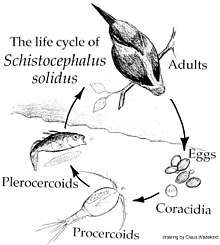Schistocephalus
| Schistocephalus solidus | |
|---|---|
 | |
| Drawing of the life cycle of Schistocephalus solidus | |
| Scientific classification | |
| Kingdom: | |
| Phylum: | |
| Class: | Cestoda (Eucestoda) |
| Order: | |
| Family: | Schistocephalidae |
| Subfamily: | Schistocephalinae |
| Genus: | Schistocephalus |
Background
Schistocephalus solidus (S. solidus), known as cestodes, or tapeworms, are found in isolated areas of western and eastern North American, including Alaska and provinces of Canada, Europe, and Eurasia. This species has been used to demonstrate that cross-fertilization produces a higher infective success rate than self-fertilization.
S. solidus is parasitic, and dependent on its host's habitat in order to infect and manipulate the behavior of the copepods, three-spined sticklebacks, and piscivorous birds. As cestodes that infect the intestinal tract of their hosts, S. solidus shares the diet of the organism where it resides. S. solidus is known to metabolize glycogen within its host [1]
Life Cycle
The life cycle of S. solidus involves hatching from eggs in freshwater through bird's feces, at approximately fourteen days many eggs have well-defined coracidia [2]. The free-swimming coracidium is usually spherical, moving fairly rapidly and smoothly. The first larval stage begins, the coracidium is produced. The coracidium is then ingested by the first intermediate host cyclopoid copepod, Macrocyclops albidus. Within one to two weeks, the infected copepod is ingested by the second intermediate host, the three-spined stickleback, Gasterosteus aculeatus. The third larval stage, the plerocercoid, grows in the abdomen of the fish. When the fish is eaten by a piscivorous bird, the larvae matures, and adults inside the piscivorous birds will reproduce sexually (outcross or selfing) in this final host, followed by fecal excretion of eggs into water.
Behavioral Manipulation
In a natural environment, infection intensity seems to be controlled by a crowding effect; no more than four Schistocephalus solidus plerocercoids have been found in a single host[3]. However, the prevalence of infection can be highly variable. S. solidus manipulates the behavior of its fish host, making it more vulnerable to predation to piscivorous birds. This makes the parasite more likely to reach its next host.
References
- Dietrich, A (2013). "Schistocephalus solidus". Cite journal requires
|journal=(help) - Dietrich, A (2013). "Schistocephalus solidus". Cite journal requires
|journal=(help) - Dietrich, A (2013). "Schistocephalus solidus". Cite journal requires
|journal=(help)